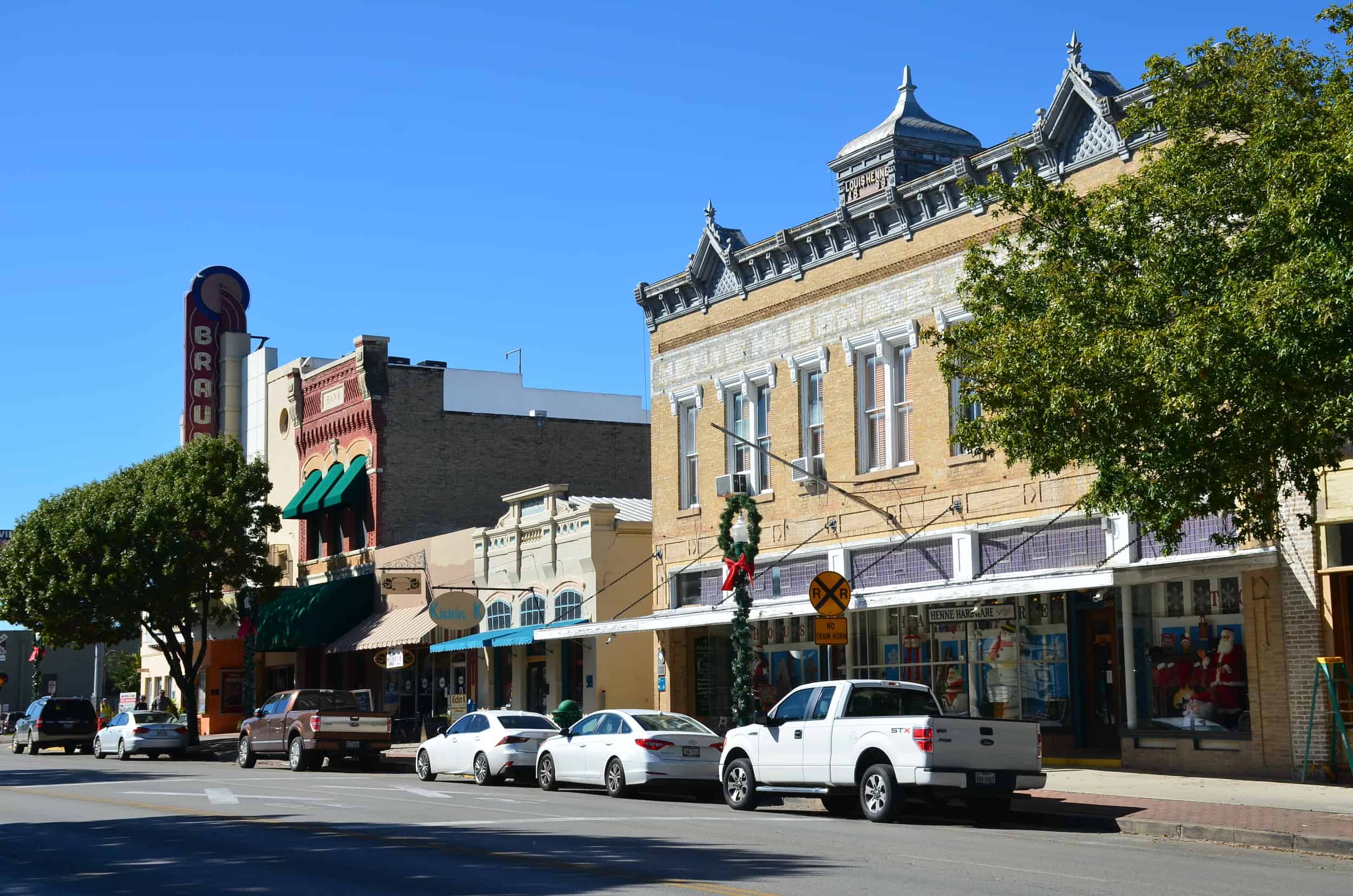Last updated on .
New Braunfels is a small city in Texas north of San Antonio famous for its German Texan heritage. There are a few interesting things to see in the downtown area.

History
New Braunfels was founded by Prince Carl of Solms-Braunfels (1812-1875), a German prince and military officer in the Austrian army. He was the Commissioner General of the Mainzer Adelsverein, which was an organization dedicated to establishing a German colony within the borders of the Republic of Texas.
Prince Carl led a group of settlers from Germany to Texas, arriving in July 1844. The following year, he purchased 1,300 acres on the Guadalupe River and named the settlement New Braunfels in honor of his home in Germany. He then traveled back to Germany in late 1845 to marry. Prince Carl never returned to Texas because his new wife refused to leave Germany.
Main Plaza
We started exploring New Braunfels in Main Plaza, which was laid out in 1845. It contains a band shell known by its German name, Der Musikpavillon, that was added in 1905. The roads around Main Plaza were paved in 1918 and accommodated two-way traffic until the 1950s, when they were changed to one-way roads.
Comal County Courthouse
On the northwest corner of the plaza is the Comal County Courthouse. It was designed by architect James Riely Gordon (1863-1937) in the Romanesque Revival style and built between 1897 and 1898.
The courthouse replaced an earlier courthouse designed by Wilhelm Thielepape (1814-1904) and completed around 1860. Thielpape was one of the original settlers that arrived in Texas with Prince Carl and later served as mayor of San Antonio. He then moved to Chicago after the Great Chicago Fire of 1871.
The Comal County Courthouse, which is three stories high, underwent an extensive three-year restoration that began in 2013.
Henne Hardware
From the plaza, we walked down West San Antonio Street, which is the heart of downtown New Braunfels. It’s lined with historic buildings filled with shops, restaurants, cafés, and more. The first building that caught my eye was the Henne Hardware Building. It was built in 1893 to house Henne Hardware, which was founded in 1857 by Louis Henne Jr. and is the oldest running hardware business in Texas.
The building was constructed by local contractor Christian Herry (1854-1917). It has a Victorian-style façade remodeled in 1910 and includes the original wooden floors, pressed tin ceilings, and decorative custom-made fixtures. The full basement features a 46-foot deep well. The metal cornice was made by Mesker Brothers Iron Works of St. Louis, Missouri.
Brauntex Theatre
A couple doors down is the Brauntex Theatre. It opened on January 6, 1942, and was a state-of-the-art movie theatre at that time. It operated as a dual screen movie theatre until May 1998. The building was rescued from demolition in 1999 and renovated as a performing arts theatre, reopening in August 2000 as the Brauntex Performing Arts Theatre.
New Braunfels Railroad Museum
Next to the theatre is the New Braunfels Railroad Museum, which is housed in the former Railroad Depot built around 1890. It was an active passenger and freight depot for the International & Great Northern Railroad from 1907 until it was abandoned in 1982. The New Braunfels Historic Railroad & Modelers Society restored the building and now operate the museum there. It’s open daily and admission is free of charge (as of May 2023).
In addition to the artifacts on display at the museum, the building also sits next to one of the busiest Union Pacific railroad tracks in the country. Over 30 freight trains pass by each day in addition to two Amtrak passenger trains running between San Antonio and Chicago.
Naegelin’s Bakery
After exploring San Antonio Street, we walked back to Main Plaza and then down South Seguin Avenue. A few more interesting buildings line this street, including historic Naegelin’s Bakery. It was founded in 1868 by Edouard Naegelin Sr. (1844-1923), and is the oldest bakery in Texas. They still use their traditional German recipes.
Faust Hotel
A bit further down and across the street is the Faust Hotel. It originally opened on October 12, 1929, as the Traveler’s Hotel by local businessman Walter Faust Sr. (1878-1933) just two weeks before the stock market crash that signaled the beginning of the Great Depression. The hotel was designed by Harvey P. Smith and renamed as the Faust Hotel in 1936.
During World War II, the Faust Hotel gained a reputation as the “honeymoon capital of Texas” because soldiers stationed nearby would celebrate their honeymoons there before being shipped off to fight. The building is also considered one of the most haunted in the state. It still operates as a hotel today.
Walter Faust House
Next door to the hotel is the Walter Faust House. It was built in 1910 in the Late Victorian-Queen Anne style. The home was purchased by the First Protestant Church (see below) in the 1950s and remodeled as a teaching facility in the 1980s. It’s now known as the Heritage House.
First Protestant Church
Finally, behind the house is the First Protestant Church. The first service was held outdoors on March 21, 1845, and a year later a log church was built on a nearby site. The current church was completed in 1875 and made of cut limestone brought from the Landa Quarry.
On display in the church is a silver chalice presented to the congregation by Prince Carl at the first service in 1845. The twin chalice is at the prince’s family castle in Braunfels, Germany.